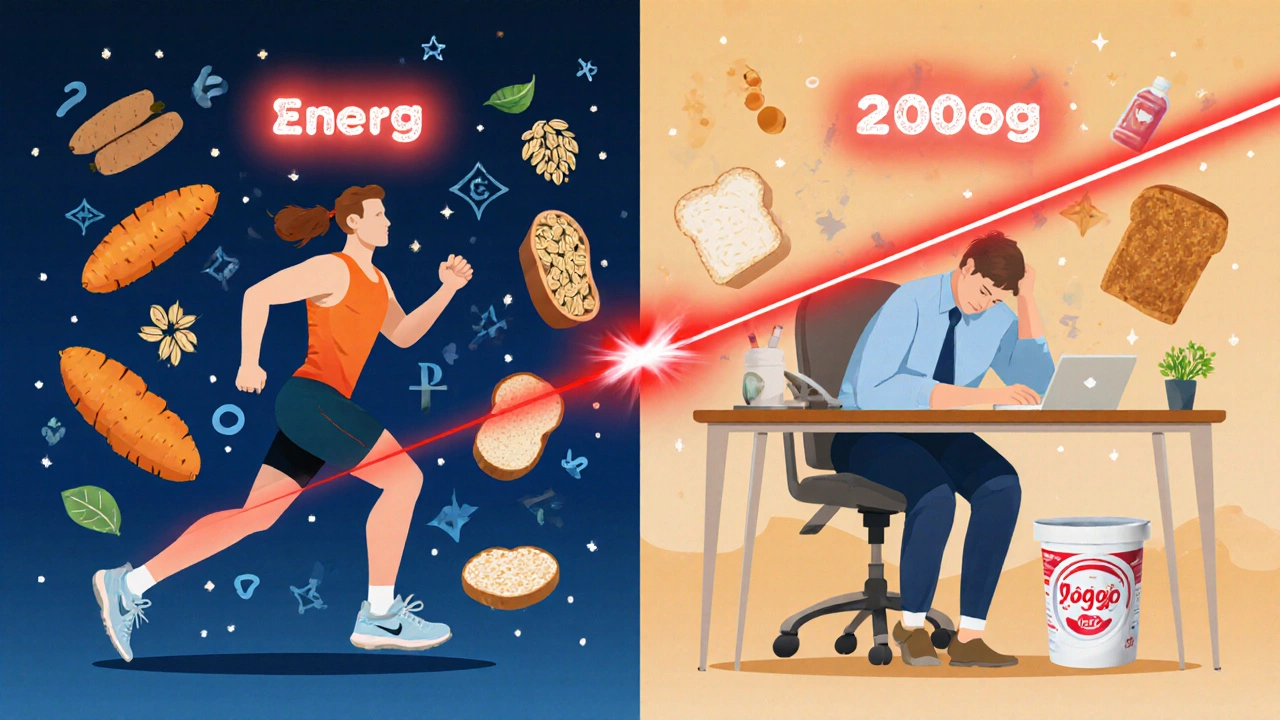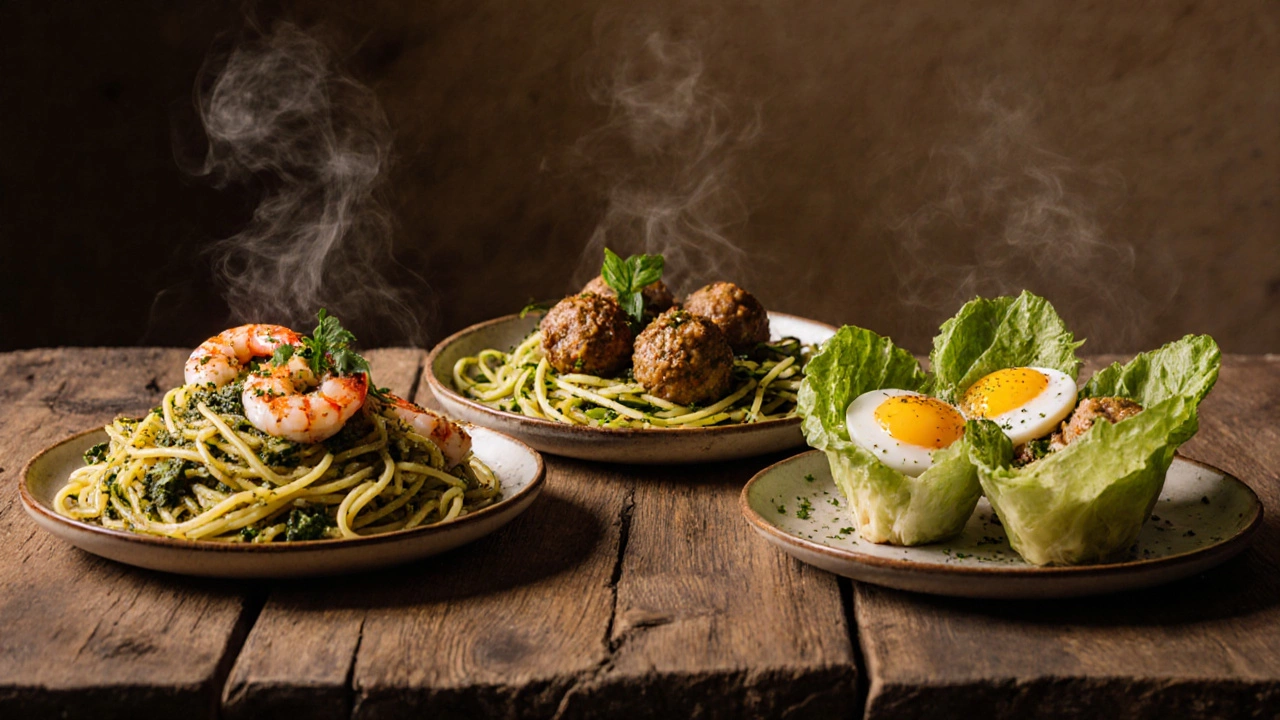Carb Intake Calculator
200g of carbs is equivalent to:
- 1 medium banana (27g)
- 1 cup cooked rice (45g)
- 2 slices whole wheat bread (30g)
- 1 large potato (37g)
- 1 cup pasta (40g)
The average American consumes 250-300g of carbs daily.
How many carbs should you eat in a day? If you’re reading this, you’ve probably heard conflicting advice-some say 200 grams of carbs is way too much, others say it’s perfectly fine. The truth? It depends on who you are, what you’re doing, and what your body needs. There’s no universal number that works for everyone. But if you’re trying to eat lower-carb meals, lose weight, or just feel better, knowing where 200 grams fits in can help you make smarter choices.
What does 200 grams of carbs actually look like?
Let’s cut through the noise. Two hundred grams of carbs isn’t just a number-it’s food. A lot of it. One medium banana has about 27 grams. A cup of cooked white rice? Around 45 grams. A slice of whole wheat bread? About 15 grams. A large potato? Nearly 37 grams. Add in pasta, cereal, fruit, yogurt, and snacks, and you’re hitting 200 grams before dinner even starts.
For someone eating a standard Western diet, 200 grams is actually on the lower end. The average American consumes around 250-300 grams of carbs daily. So 200 isn’t extreme-it’s moderate. But if you’re trying to reduce carbs for health reasons, it’s still a lot. Many people who follow low-carb diets aim for 50-100 grams per day. That’s not because carbs are evil, but because cutting them helps control blood sugar, reduce cravings, and burn fat more efficiently.
Who should eat 200 carbs a day?
Not everyone needs to cut carbs. If you’re active-running, lifting weights, playing sports, or doing physically demanding work-200 grams might be just right. Your muscles need glycogen, and carbs are the easiest way to refill it. A 180-pound athlete training five days a week might burn 500-800 grams of glycogen in a week. That’s 70-110 grams per day just to keep up. So for them, 200 grams isn’t too much-it’s necessary.
Same goes for people with high stress levels or poor sleep. Cortisol spikes when you’re run down, and your body turns to carbs for quick energy. Cutting carbs too fast in that state can make you feel worse-tired, irritable, hungrier. If you’re not sedentary, not struggling with weight gain, and not dealing with insulin resistance, 200 grams won’t hurt you.
Who should cut back?
If you’re carrying extra weight, especially around your midsection, or if you feel sluggish after meals, 200 grams might be too much. Blood sugar spikes from refined carbs-white bread, sugary drinks, pastries-lead to crashes. That’s when you get hungry again an hour later, reach for snacks, and end up eating more than you meant to.
Insulin resistance is another red flag. Your body starts storing fat instead of burning it, even if you’re eating ‘healthy’ carbs. Studies show that people with prediabetes or metabolic syndrome often see big improvements cutting carbs to 100-150 grams per day. Some even drop to 50 grams and reverse their condition. That’s not magic-it’s biology.
And if you’ve tried low-fat diets and kept gaining weight? You’re not alone. For many, the real problem isn’t fat-it’s too many carbs, especially processed ones. Your body doesn’t need them to survive. It needs protein, healthy fats, fiber, and micronutrients. Carbs are optional.

Low-carb recipes that keep you full
If you’re thinking about dropping below 200 grams, you don’t have to eat bland chicken and broccoli every night. Real low-carb eating is satisfying. Here’s what works:
- Spaghetti squash with pesto and grilled shrimp-under 10 grams of net carbs per serving, packed with flavor.
- Zucchini noodles with turkey meatballs and tomato sauce-swap pasta for spiralized zucchini and cut 40 grams of carbs instantly.
- Cauliflower rice stir-fry with tofu and sesame oil-adds volume without the spike.
- Avocado and egg salad in lettuce cups-no bread, no guilt, just healthy fats and protein.
- Dark chocolate (85% or higher) with almonds-a sweet treat under 10 grams of carbs.
These aren’t diet foods. They’re real meals that fill you up and keep your energy steady. No hunger pangs by 3 p.m. No afternoon crash. No midnight snacking.
How to track your carbs without obsessing
You don’t need to weigh every grain of rice. Start simple. Use a free app like Cronometer or MyFitnessPal for a week. Just log what you eat. You’ll be shocked. That ‘healthy’ granola bar? 30 grams of carbs. The ‘low-fat’ yogurt? 22. The ‘whole grain’ wrap? 40. Suddenly, 200 grams feels like a lot.
After a week, you’ll start noticing patterns. You’ll know which foods spike your hunger. Which ones make you feel clear-headed. You’ll start choosing differently-not because you’re on a diet, but because you feel better.
Then, set your own range. If you feel great at 150, stick there. If you need 180 to keep up with your workouts, go for it. The goal isn’t to hit a number. It’s to feel your best.

Carbs aren’t the enemy-processed carbs are
It’s easy to blame carbs. But the real issue isn’t the carb itself. It’s the form it comes in. Whole foods like sweet potatoes, berries, oats, and legumes come with fiber, vitamins, and minerals. They digest slowly. They don’t spike insulin. They’re part of a healthy diet for most people.
The problem is refined carbs: white flour, sugar, high-fructose corn syrup, and anything in a package that says ‘low-fat’ or ‘fortified.’ These are the ones that turn into sugar fast. They’re the ones that make you crave more. They’re the ones linked to weight gain, inflammation, and type 2 diabetes.
So don’t cut all carbs. Cut the bad ones. Keep the good ones. And if you’re not sure which is which, ask: Did this come from the ground or a factory?
What happens when you drop below 200 carbs?
When you reduce carbs to 100-150 grams a day, most people notice changes within a week:
- Less bloating and water retention
- More stable energy-no afternoon slumps
- Fewer cravings for sugar and snacks
- Better sleep
- Clearer skin
Some people lose weight quickly at first-not because they’re starving, but because they’re not storing as much water. Carbs hold water. Cut them, and you lose a few pounds of fluid. Then the fat loss starts, slow and steady.
Don’t expect miracles. But do expect to feel more in control. More awake. Less at the mercy of your hunger.
Final thought: It’s not about the number-it’s about the effect
Is 200 carbs a day a lot? Compared to the average American diet? No. Compared to what your body actually needs? Maybe. The best diet isn’t the one with the lowest carbs. It’s the one that makes you feel good, gives you energy, and lets you stick with it long-term.
If you’re happy, energized, and not gaining weight at 200 grams, keep going. If you’re tired, hungry, or stuck, try cutting back. Start with one swap: replace pasta with zoodles. Swap cereal for eggs. See how you feel. Your body will tell you what it needs.
You don’t need a diet. You just need to listen.

